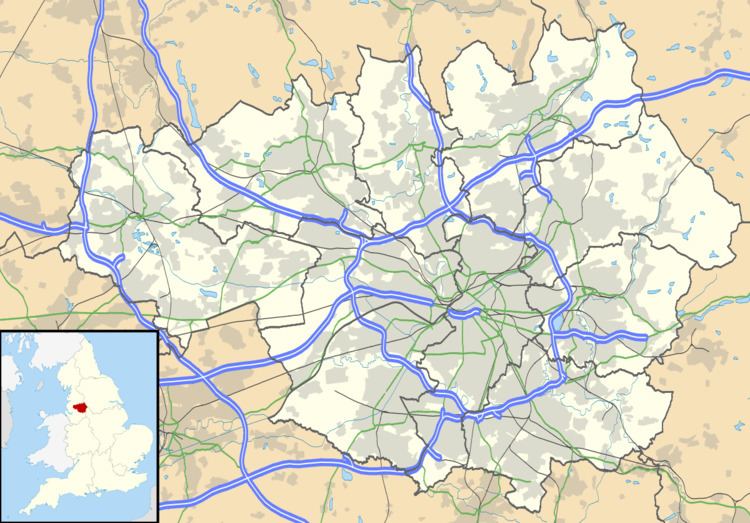Structural system wooden floored Engine maker Hunt Floor count 5 Year 1782 | Floor area 60.9m X 9.1m Demolished 1940 Renovated 1854 (After fire) | |
 | ||
Alternative names Simpson's Mill, Old Mill Owner Arkwright, Whittenbury, Brocklebank, Simpson and Simpson Further ownership 1786 (Simpson and Simpson) | ||
Shudehill Mill or Simpson's Mill was a very early cotton mill, in the centre of Manchester, England. It was built in 1782 by partners of Richard Arkwright, and destroyed by fire in 1854, rebuilt and finally destroyed during the Manchester blitz in 1940. It was one of the larger Arkwright mills, built 3 years before his patent lapsed. In order to provide the water flow over its 9.1m diameter water wheel, a Newcomen atmospheric engine was installed. Doubts remain as to the actual function of this engine, whether it was a failed attempt to power a mill directly by steam that was modified to assist the wheel. Some believed that this engine, constructed by Hunt, could have been one of the thirteen engines installed into Manchester mills by Joshua Wrigley. Water flowed from the upper storage pond over the water wheel to drive the mill. The steam engine recycled the water up from the lower storage pond to the upper storage pond. This was soon augmented by three Boulton and Watt engines to provide power for the increasing number of spindles. The mill was damaged by fire in 1854, and destroyed in an air-raid in October 1940.
Contents
Location
Shudehill is an area in the centre of Manchester, near its highest point. Shudehill mill was built between Miller Street and Angel Street to the north of Rochdale Road; it is now a car park. The River Irwell and Mersey had been made navigable as far as Manchester in the 1720s, which opened the way for importing cotton and exporting the cloth. The Bridgewater Canal ran from the coal fields at Worsley to the Castlefield Basin; it opened in 1761. Arkwright had patented a water frame for the spinning of cotton, and then in 1775 he solved the other problem by patenting a mechanical carding engine. He took out a second patent that year for drawing and roving. All the pieces were in place for a large automated spinning mill to be built in Manchester. Shudehill Mill which was a watermill, was not on any stream, but derived its power from cycling water between two storage ponds, a steam pump was used to replenish the upper pond from the lower.
Shudehill Mill was close to three of Manchester's great stations, Manchester Victoria railway station, Manchester Exchange railway station and Oldham Road railway station. Shudehill Interchange is the present metro station. The mill itself would lie under the shadow of the CIS Tower. The Shudehill Conservation Area is the other side of the tower.
History
The site was originally used as a brick works; it was purchased in 1781, by Arkwright and his partners. Simpsons Mill was a five storey, Arkwright type mill 9.1 m wide and 60.9m long. It housed water frames, carding machines and roving and drawing frames using designs patented by Arkwright. It was driven by a 9.1 m diameter waterwheel driven from the upper storage pond. A steam engine drove a water pump to send the water back to the upper pond. It is thought that the steam engine was of the Newcomen type, though some sources speculate that it could have been of the Savery type. The pump had two cylinders, 31 in in diameter and a stroke of 7 ft 9 in- the steam cylinder was 64 in in diameter. It operated at 11-12 strokes per minute. It used 5 tonnes of coal a day. It was perhaps because of this excessive coal consumption, that it was supplemented in 1790 with a 6 hp, Boulton and Watt rotative engine. They ran 4,000 spindles. A year later in 1791 they ordered a 40 hp rotative engine to replace them. This was the largest engine that Boulton and Watt had made at that time, and it was operating by the end of the summer in 1792. . A further 30 hp Boulton and Watt was bought in 1799. The mill was destroyed by fire in 1854.
By 1888 it had been rebuilt using many of the original walls. It was at this stage that two extra storeys were added. The two reservoirs were filled in- it operated under steam. Then in October 1892, the mill was sold to Baxendale and Co., a firm of engineers and plumbers' merchants. They described 'the structure, of the mill, was massive brickwork with very heavy wooden floors supported by corbels in the walls.' They redeveloped the site. By 1908 the main building was subdivided. Baxendales mill was destroyed by enemy action on the night of 23 October 1940. The site remained derelict until it was redeveloped by NCP as a car-park.
Architecture
Simpsons Mill was a five storey, Arkwright type mill said to be 9.1 m wide and 60.9m long. Baxendaleś mill was seven storeys, and used the same massive walls. In 2004, an archaeological dig was done on the site to try to solve some outstanding questions. It had been claimed that the Newcomen engine was not used as a pumping engine, but was an attempt that failed to power the mill directly from steam. The original width of the first mill was in doubt, and the position of the wheel pit not known. The results suggest that the mill was always 12m wide, and the wheel pit was internal to the mill. The original function of the Newcomen engine remains undecided.
Power
The engine house and the chimney were detached from the mill, though a later engine house may have been built adjacent to the centre on the eastern side.
